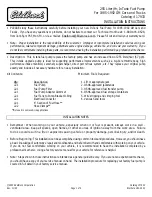
Should this occur, you should stop as soon as
possible and inflate the tires with a low pressure
condition (those in a different color in the instru-
ment cluster display graphic) to the vehicle’s
recommended cold placard pressure inflation
value as shown in the
"
Inflate to XX
"
message.
Once the system receives the updated tire pres-
sures, the system will automatically update, the
graphic display in the instrument cluster will
change color back to the original color, and the
TPM Telltale Light will turn off. The vehicle may
need to be driven for up to 20 minutes above
15 mph (24 km/h) in order for the TPMS to
receive this information.
Service TPMS Warning
If a system fault is detected, the TPM Telltale
Light will flash on and off for 75 seconds and
then remain on solid. The system fault will also
sound a chime. In addition, the instrument clus-
ter will display a
"
SERVICE TPM SYSTEM
"
message for a minimum of five seconds and
then display dashes (- -) in place of the pressure
value to indicate which sensor is not being
received.
If the ignition switch is cycled, this sequence will
repeat, providing the system fault still exists. If
the system fault no longer exists, the TPM
Telltale Light will no longer flash, and the
"
SER-
VICE TPM SYSTEM
"
message will no longer
display, and a pressure value will display in
place of the dashes. A system fault can occur
due to any of the following:
1. Signal interference due to electronic devices
or driving next to facilities emitting the same
radio frequencies as the TPM sensors.
2. Installing aftermarket window tinting that
contains materials that may block radio wave
signals.
3. Accumulation of snow or ice around the
wheels or wheel housings.
4. Using tire chains on the vehicle.
5. Using wheels/tires not equipped with TPM
sensors.
TPMS Deactivation — If Equipped
The TPMS can be deactivated if replacing all
four wheel and tire assemblies (road tires) with
wheel and tire assemblies that do not have
TPMS Sensors, such as when installing Winter
wheel and tire assemblies on your vehicle. To
deactivate the TPMS, first, replace all four wheel
and tire assemblies (road tires) with tires not
equipped with Tire Pressure Monitoring (TPM)
Sensors. Then, drive the vehicle for 10 minutes
above 15 mph (24 km/h). The TPMS will chime,
the “TPM Telltale Light” will flash on and off for
75 seconds and then remain on and the instru-
ment cluster will display the “SERVICE TPM
SYSTEM” message and then display dashes
(--) in place of the pressure values. Beginning
with the next ignition switch cycle, the TPMS will
no longer chime or flash the TPM telltale and
display the “SERVICE TPM SYSTEM” message
in the instrument cluster display but dashes (--)
will remain in place of the pressure values.
To reactivate the TPMS, replace all four wheel
and tire assemblies (road tires) with tires
equipped with TPM sensors. Then, drive the
vehicle for up to 10 minutes above 15 mph
(24 km/h). The TPMS will chime, the “TPM
Telltale Light” will flash on and off for 75 seconds
and then turn off, and the instrument cluster will
display the “SERVICE TPM SYSTEM” mes-
sage. The instrument cluster will also display
pressure values in place of the dashes. On the
next ignition switch cycle the “SERVICE TPM
SYSTEM” message will no longer be displayed
as long as no system fault exists.
FUEL REQUIREMENTS
8.4L Engine
The 8.4L engine is designed to meet all emis-
sions regulations and provide excellent fuel
economy and performance when using high-
quality premium unleaded gasoline with an Re-
search Octane Number (RON) of 98 or higher.
While operating on gasoline with the required
octane number, hearing a light knocking sound
from the engine is not a cause for concern.
However, if the engine is heard making a heavy
knocking sound, see your dealer immediately.
Use of gasoline with a lower than recommended
octane number can cause engine failure and
may void or not be covered by the New Vehicle
Limited Warranty.
133
Summary of Contents for Viper 2017
Page 2: ......
Page 3: ......
Page 5: ...2...
Page 45: ...42...
Page 100: ...Overview 8 4 NAV Temperature Controls 97...
Page 107: ...Operating Tips Chart 104...
Page 113: ...110...
Page 180: ...8 MAINTENANCE SCHEDULES MAINTENANCE SCHEDULE 178 177...
Page 181: ...MAINTENANCE SCHEDULE Refer to the Service And Warranty Handbook for maintenance schedules 178...
Page 182: ...9 IF YOU NEED CONSUMER ASSISTANCE IF YOU NEED ASSISTANCE 180 179...
Page 184: ...181...
Page 185: ...182...
Page 186: ...10 INDEX 183...
Page 200: ...8...
Page 201: ......
Page 202: ......
Page 204: ...7 9 9 B 9 B...
Page 205: ...I B I...
Page 206: ......
Page 207: ......
Page 234: ...8 4 1 5 0 6 O v T Ry 2 E H O 7 E H 3 R 5 I2 8 R 2 4 2 9 5 O RO eI2 eR 5...
Page 247: ......
Page 282: ...X...
Page 384: ...F G H J 8 L H 9 M 9 G...
Page 385: ......
Page 386: ...2 3 4 5 67 8 9 7 9 9 B 8...
Page 387: ......
Page 388: ......
Page 389: ...Viper 1 7 Z D 1 2 6 A R A A A...
















































